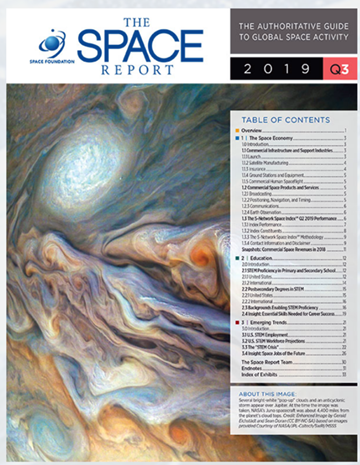
Revenues from global commercial space activity in 2018 climbed to their highest level ever and now make up nearly 80 percent of the total global space industry, according to new findings from The Space Report Quarter Three.
The Space Foundation has just published the third quarter 2019 issue of The Space Report and shared other key findings:
- Global commercial space activity in 2018 reached $328.86 billion, a 6.6 percent improvement over 2017.
- Space products and services, a sector of commercial space revenue, totaled $229.17 billion, an 8.4 percent gain over 2017.
- Commercial space infrastructure and support industries, the other main sector, experienced a more modest 2.6 percent yearly revenue increase, but still edged closer to the milestone $100 billion mark with annual revenue of $99.69 billion.

The recent success of commercial space activity can be traced back more than 13 years, when U.S. government leaders and business entrepreneurs realized that vast opportunities — in economic development, technological advancement, and scientific knowledge — awaited in space.
New federal legislation, the Commercial Space Launch Amendments Act, was passed in 2004, the same year SpaceShipOne successfully completed the first privately crewed spaceflights in history. Those two events helped trigger a new era of commercial enterprise. From 2005 to 2018, according to The Space Report, commercial space revenue more than doubled, growing 162 percent.
The Space Report is widely recognized as the definitive body of information about the global space industry. It contains worldwide space facts and figures and is illustrated with photographs, charts, and graphs detailing the benefits of space exploration and utilization. The report is a resource for government and business leaders, educators, financial analysts, students, and space-related companies.
Its analysis also extends to the education and workforce issues that will shape current and future endeavors in space. For the third-quarter issue, The Space Report also examined global and national test results for science, technology, engineering, and mathematics (STEM) subjects. Among the findings:
- In 2016, the United States awarded 568,000 STEM degrees. The majority were awarded to foreign nationals studying in the U.S.
- The U.S. awarded only 6 percent of all STEM degrees globally in 2016. China produced eight times as many — approximately 4.7 million degrees — and produced more than half of all STEM graduates in the world in 2016.
- Based on international testing of students in 72 countries, only 54 percent of students tested were considered proficient in math and science.
The Space Foundation’s Research & Analysis team produces The Space Report and earlier this year transitioned from an annual summary to quarterly updates of global space activity.

